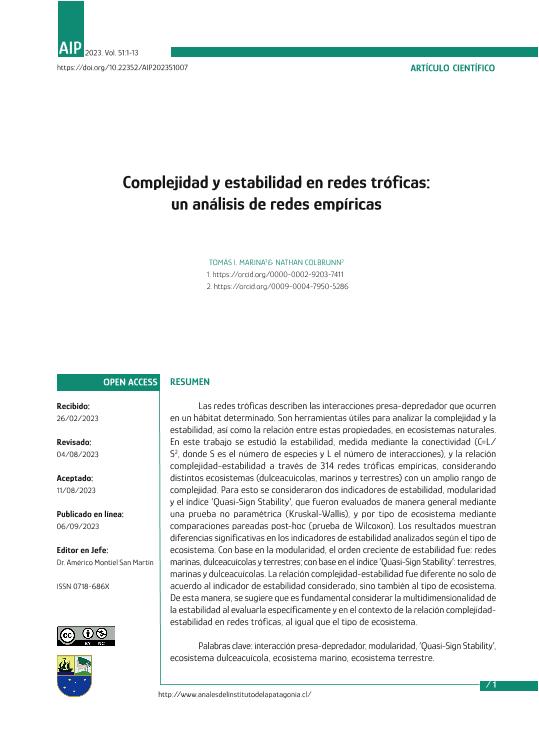Mostrar el registro sencillo del ítem
dc.contributor.author
Marina, Tomas Ignacio

dc.contributor.author
Colbrunn, Nathan
dc.date.available
2023-12-26T10:37:34Z
dc.date.issued
2023-09
dc.identifier.citation
Marina, Tomas Ignacio; Colbrunn, Nathan; Complejidad y estabilidad en redes tróficas: un análisis de redes empíricas; Universidad de Magallanes; Anales del Instituto de la Patagonia; 51; 9-2023; 1-13
dc.identifier.issn
0718-686X
dc.identifier.uri
http://hdl.handle.net/11336/221306
dc.description.abstract
Las redes tróficas describen las interacciones presa-depredador que ocurren en un hábitat determinado. Son herramientas útiles para analizar la complejidad y laestabilidad, así como la relación entre estas propiedades, en ecosistemas naturales. En este trabajo se estudió la estabilidad, medida mediante la conectividad (C=L/S2, donde S es el número de especies y L el número de interacciones), y la relación complejidad-estabilidad a través de 314 redes tróficas empíricas, considerando distintos ecosistemas (dulceacuícolas, marinos y terrestres) con un amplio rango de complejidad. Para esto se consideraron dos indicadores de estabilidad, modularidad y el índice ‘Quasi-Sign Stability’, que fueron evaluados de manera general mediante una prueba no paramétrica (Kruskal-Wallis), y por tipo de ecosistema mediante comparaciones pareadas post-hoc (prueba de Wilcoxon). Los resultados muestran diferencias significativas en los indicadores de estabilidad analizados según el tipo de ecosistema. Con base en la modularidad, el orden creciente de estabilidad fue: redes marinas, dulceacuícolas y terrestres; con base en el índice ‘Quasi-Sign Stability’: terrestres, marinas y dulceacuícolas. La relación complejidad-estabilidad fue diferente no solo de acuerdo al indicador de estabilidad considerado, sino también al tipo de ecosistema. De esta manera, se sugiere que es fundamental considerar la multidimensionalidad de la estabilidad al evaluarla específicamente y en el contexto de la relación complejidad estabilidad en redes tróficas, al igual que el tipo de ecosistema.
dc.description.abstract
Food webs describe the predator-prey interactions that occur in a given habitat. They are useful tools for analyzing complexity and stability, as well as the relationship between these properties, in natural ecosystems. In this work we studied stability, measured as connectance (C=L/S2 , where S is the number of species and L the number of interactions), and the complexity-stability relationship in 314 empirical food webs considering different type of ecosystems (freshwater, marine and terrestrial) in a wide complexity range. For this we considered two indicators of stability, modularity and the ‘Quasi-Sign Stability’ index, which we evaluated generally using a non-parametric test (Kruskal-Wallis), and by ecosystem type applying post-hoc comparisons (Wilcoxon test). Our results show significant differences in the stability indicators analyzed according to the type of ecosystem. Based on modularity, the increasing order of stability was: marine, freshwater and terrestrial networks; based on the ‘Quasi-Sign Stability’ index: terrestrial, marine and freshwater. The complexity-stability relationship was different not only according to the stability indicator considered, but also the type of ecosystem. In this sense, we suggest that it is essential to consider the multidimensionality of stability when evaluating it specifically and in the context of the complexity-stability relationship in food webs, as well as the type of ecosystem.
dc.format
application/pdf
dc.language.iso
spa
dc.publisher
Universidad de Magallanes
dc.rights
info:eu-repo/semantics/openAccess
dc.rights.uri
https://creativecommons.org/licenses/by-nc-sa/2.5/ar/
dc.subject
INTERACCION PRESA-DEPREDADOR
dc.subject
MODULARIDAD
dc.subject
QUASI-SIGN STABILITY
dc.subject
ECOSISTEMA
dc.subject.classification
Biología Marina, Limnología

dc.subject.classification
Ciencias Biológicas

dc.subject.classification
CIENCIAS NATURALES Y EXACTAS

dc.title
Complejidad y estabilidad en redes tróficas: un análisis de redes empíricas
dc.title
Complexity and stability in food webs: an empirical analysis
dc.type
info:eu-repo/semantics/article
dc.type
info:ar-repo/semantics/artículo
dc.type
info:eu-repo/semantics/publishedVersion
dc.date.updated
2023-12-21T13:38:22Z
dc.journal.volume
51
dc.journal.pagination
1-13
dc.journal.pais
Chile

dc.description.fil
Fil: Marina, Tomas Ignacio. Consejo Nacional de Investigaciones Científicas y Técnicas. Centro Austral de Investigaciones Científicas; Argentina
dc.description.fil
Fil: Colbrunn, Nathan. No especifíca;
dc.journal.title
Anales del Instituto de la Patagonia
dc.relation.alternativeid
info:eu-repo/semantics/altIdentifier/url/https://analesdelinstitutodelapatagonia.cl/article/view/1037
dc.relation.alternativeid
info:eu-repo/semantics/altIdentifier/doi/http://dx.doi.org/10.22352/AIP202351007
Archivos asociados
